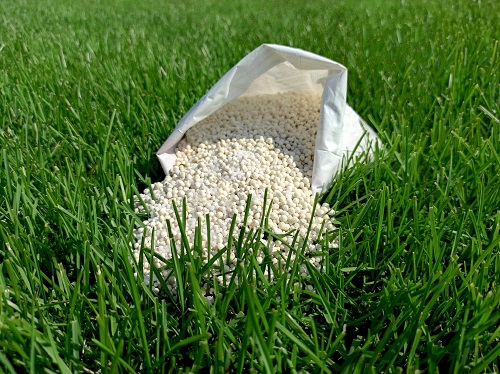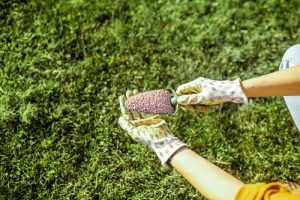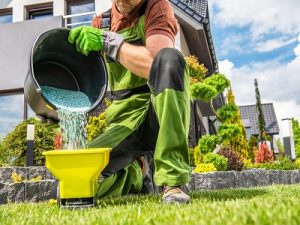
Beautiful lawns do not just happen. They are carefully planned and designed. The creation of a lawn will never be complete without the use of fertilizer. There is a lot of confusion about fertilizers and their use. Here are some lawn care tips you need to know.
To choose the best fertilizer, you must first determine what nutrients your soil contains. This can be done by conducting a soil analysis.
The soil nutrients, whether you place them there or they occur naturally, work together to assist grass in achieving its primary goal. Photosynthesis is the primary purpose of grass. The process of photosynthesis is how grass produces its own food.
Photosynthesis occurs when the blades of the plant absorb sunlight, and the roots reach down into the soil in order to get the nutrients needed to perform their function. This is an oversimplification of a complex process. We will not go into detail.
If you don’t fertilize your lawn, it will be completely dependent on the nutrients in the soil. As you may know, the soil around many homes isn’t very good. Contractors rarely give much thought to the soil quality after a home is built. It doesn’t matter how the land is graded, as long as it is done correctly.
Lawn Care Tips
MICRONUTRIENTS & MACRONUTRIENTS
To stay healthy and perform essential plant functions, lawn grasses require several micronutrients as well as macronutrients.
What is in lawn fertilizer?
What is in fertilizer, you ask? The three numbers on the bag of fertilizer represent three macronutrients: Phosphorus (in that order), Nitrogen and Potassium.
The three numbers on the bag are the most important nutrients for grass. The other nutrients are still important for the health and life of the grass.
The numbers on the bag indicate the weight percentage of each element.
 Types of Fertilizer
Types of Fertilizer
The most common type of synthetic fertilizer is liquid. It also comes in granular form. Granular fertilizers require less equipment and are easier to use. You only need a rotary spreader or a drop spreader.
Liquid Fertilizer
Unless the liquid lawn fertilizer is a small hose-end type like Miracle Gro, it may require special equipment for application. The majority of liquid fertilizers are only available to professional companies, due to the high cost of equipment needed to quickly cover large areas.
For small lawns, you can also use a backpack or hand-held sprayer. You can buy 10 or 20-gallon sprayers in your local farm and home shop for larger lawns. The majority of sprayers require a 12-volt battery.
Which is the best liquid or dry fertilizer? Both perform about the same. Only licensed professional lawn care experts can purchase this expert-grade fertilizers, but there are many varieties available for homeowners.
When used on turfgrass the effects of fertilizers are not as bad as once believed.
All-Mineral vs. Slow Release Lawn Fertilizer
Not all fertilizers, however, are the same. Some fertilizers are called “all mineral”, meaning that all elements are released as soon as the water is applied.
Mineral lawn fertilizers tend to be the least expensive. You can buy a 50lb. bag at some feed stores for less than $10.00. The bags are often devoid of instructions on storage, safe use, or how much to apply. On the bag I saw, it said that you would need to contact the company to get this information.
They must be used with caution due to their high salt content and thoroughly watered after use in order to avoid any burning of the lawn. While these fertilizers are useful in certain situations, there is a safer and more effective lawn fertilizer available for the majority of homeowners.
Slow Release Nitrogen
Fertilizers that are more expensive will often contain ingredients of higher quality and may have multiple forms of nitrogen available. At least one nitrogen form in the bag is usually slow-release. Blending different ingredients that release at different rates allows them to be marketed under the names “spring”, “summer”, “fall”, or “winterizer”.
 ORGANIC LAWN FERTILIZERS
ORGANIC LAWN FERTILIZERS
Organic fertilizers are available in a variety of forms and will contain a greater range of micronutrients.
Certified Organic lawn fertilizer means that it is “all-natural” and does not contain synthetic materials. It doesn’t necessarily mean that it hasn’t been processed. Who wants raw manure? These products slowly fertilize grass as soil microorganisms convert the organic matter to elements that the grassroots can absorb. It is easy to over-fertilize organic lawn fertilizer because it’s safe.
Organic Types
Milorganite is a human sludge that comes from Milwaukee Sewage Treatment Plants. It is a very slow-release product and only used in the summer.
Manure: Chicken, turkey, horse, and cattle products. Bat Guano is one of the more expensive products.
Plant by-products, such as corn gluten. Some commercial products are made from food waste.
Bridge Products
Bridge products are organic fertilizers blended with synthetics.
Some lawn fertilizers contain up to 90% organic matter, and they are blended for the best performance at different times of the season. The soil microorganisms in the soil are less active during cold weather, and more active during summer. Therefore, summer blends contain higher amounts of organic material. In cooler weather, the synthetics combined with organics will give the grass immediate nutrients.
It is important to know what your soil contains before you start your fertilization program and buy your first bag. This will allow you to correct any problems that may arise. Below you will find links to detailed information about how to analyze a soil report and how to collect a sample of soil.
Find out more about lawn fertilizers, fertilization, and how to use them. Call Conway Lawn Care Service now.
Like our Facebook page for more great info about lawn maintenance services.
Conway Lawn Care Service
Conway, SC 29526
843-353-2259
http://conwaylawncareservices.com/
No comments:
Post a Comment